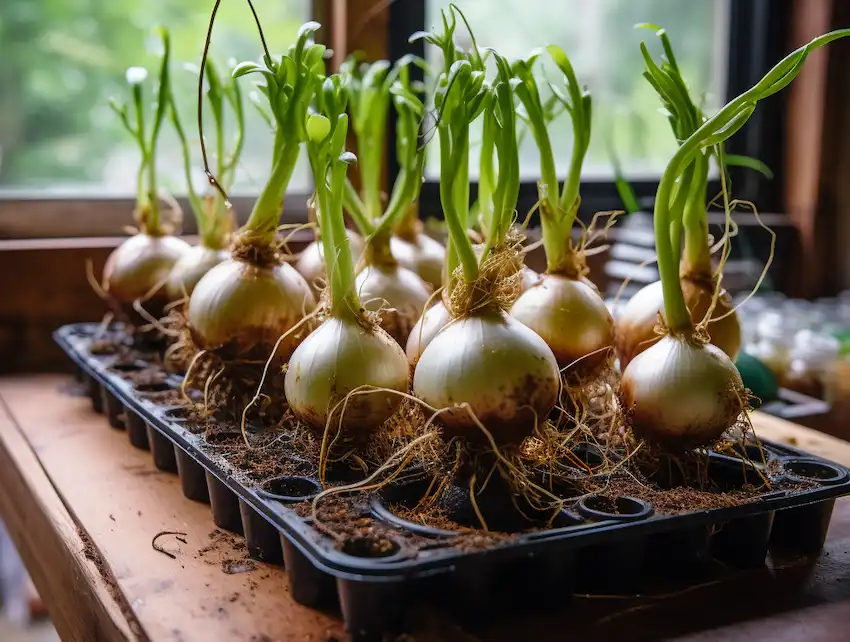Growing Onions Without Soil on a Banana Tree: A Unique Guide
Growing onions without soil, especially on a banana tree, is an innovative and sustainable gardening technique that leverages the unique structure of the banana tree to support onion growth. This method combines aspects of symbiotic planting with space-saving solutions. Here’s a comprehensive guide on how to successfully implement this method:
1. Understanding the Concept
Banana trees are large tropical plants that can grow up to two meters high and have broad leaves. Beyond producing bananas, their trunks can be utilized as a planting medium for crops like onions. This method uses the banana tree’s trunk as an unconventional growing medium, allowing onions to grow without traditional soil.
2. Preparing for Planting
Site Selection:
- Identify a healthy banana tree in your garden. Ensure it is well-established and in good health.
Preparation:
- Hole Creation: Choose a spot on the banana tree’s trunk where you will plant the onions. Carefully make a small hole about the size of an onion seed (approximately 1 cm in diameter) and about 10 cm away from the main trunk. Ensure you do not damage the banana tree’s trunk or its vascular system during this process.
3. Planting Process
Planting Onions:
- Seed Placement: Insert onion seeds into the holes you created in the banana tree’s trunk. Since the goal is to harvest the green leaves rather than the bulbs, ensure the seeds are placed correctly and at a depth where they can sprout.
Nutrient Absorption:
- The onion seeds will absorb nutrients and water directly from the banana tree’s trunk, eliminating the need for separate irrigation.
4. Caring for the Onions
General Care:
- Sunlight: Ensure that the onions receive adequate sunlight. The banana tree’s canopy should not overly shade the onions. If necessary, trim the tree’s leaves to allow more light to reach the onions.
- Pest Management: Monitor for pests and diseases. While the banana tree provides moisture, it’s essential to check for any signs of pest infestations or diseases that could affect the onions.
Moisture Management:
- Since the onions draw moisture from the banana tree, over-watering is not a concern. However, ensure that the banana tree itself is well-watered to maintain the health of both the tree and the onions.
5. Harvesting
Timing:
- Onions are typically ready for harvest when their leaves begin to yellow and fall over. In this method, you will primarily be harvesting the green leaves rather than the bulbs.
Harvesting Process:
- Gently pull or cut the onion greens from the trunk when they reach the desired length. Since you’re not growing the bulbs, focus on harvesting the leafy greens as needed for culinary use.
Alternative Hydroponic Method
If you don’t have access to a banana tree or prefer a more controlled environment, consider hydroponic cultivation:
Hydroponic Setup:
- Nutrient Solution: Use a nutrient-rich solution in a water reservoir to support onion growth. Ensure the solution is well-balanced to meet the onions’ nutritional needs.
- Growing Medium: Employ a growing medium such as perlite or rockwool to anchor the onions and support their root system.
- Water Reservoir: Maintain a water reservoir at least 6-8 inches deep to ensure proper root development and growth.
Care and Maintenance:
- Regularly monitor the pH and nutrient levels of the hydroponic solution. Adjust as needed to optimize onion growth.
Conclusion
Growing onions without soil on a banana tree is an intriguing and sustainable gardening method that maximizes the use of available resources. By following these steps, you can successfully grow onion greens and enjoy a fresh supply of this versatile herb. Alternatively, hydroponic cultivation offers a viable soil-less option for those who prefer a more controlled growing environment. Embrace these innovative techniques to enhance your gardening experience and contribute to sustainable practices.

